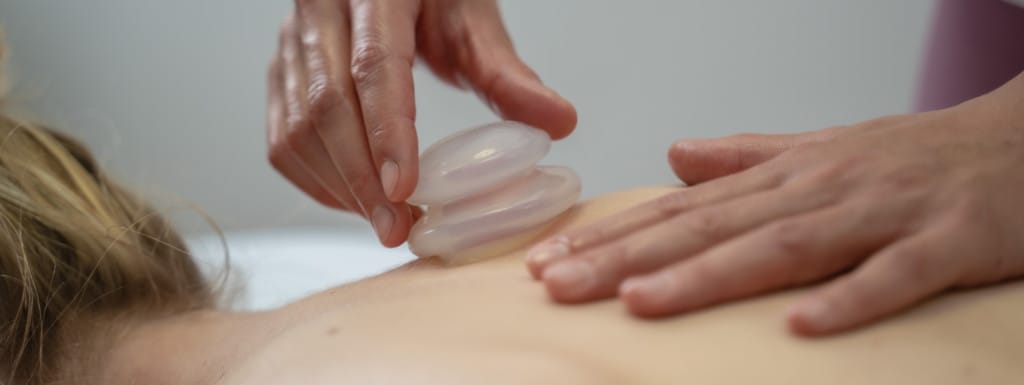
What are therapeutic cups ?
They are bell-shaped instruments that manual therapists such as massage therapists, osteopaths and acupuncturists can use as part of their practice. They can be applied to most parts of the body, for example to a trigger point or tension chain, to relieve pain and loosen tissue.
In massage therapy, therapeutic cupping is most often used to complement a treatment, regardless of the massage technique used.
A few words on therapeutic cups
The idea behind suction cups is to generate a negative pressure (vacuum) on the skin. This suction effect creates a decompression of the underlying tissues, which creates space between the different layers of the skin (e.g. epidermis, dermis, hypodermis), the fascia and the muscle fibres. Cupping also causes a flow of blood to the area being worked on, which promotes the body’s self-healing processes.
There are two ways of using therapeutic cupping:
- Wet cupping, practiced in Quebec by trained acupuncturists, involves piercing the skin with a sterile needle. The cup is then applied to decongest the area, while blood and lymph are drained into the instrument.
- Dry cupping is applied to healthy (unpierced) skin. It should be noted that massage therapists can only use dry cupping.
What are the benefits of therapeutic cups?
Massage therapists can use therapeutic cups for a variety of reasons, including pain relief (e.g. neck pain, low back pain, sciatica, plantar fasciitis, tendinopathy, carpal tunnel syndrome, etc.).
Because they have a direct effect on blood circulation and create space in the area being worked on, cupping has many benefits, for example
- Relief of acute or chronic pain
- Improved flexibility and mobility of joints
- Reduction of muscle tension
- Stress reduction and relaxation
Contraindications
The use of therapeutic cupping should be avoided in the following situations:
- Fever
- Active infection
- Recent scarring
In addition to these general contraindications, several adaptations may be necessary depending on the person’s health condition. For example, its application in pregnant women should be avoided in the lower back and abdomen.
It should be noted that the massage therapist always collects information from the client before beginning the session. This information is used, among other things, to identify any contraindications to the use of therapeutic cupping. In doing so, the massage therapist may refer the client to the appropriate medical resource or adjust the treatment accordingly to ensure safety.
Course of the session
A massage therapy treatment that includes therapeutic cupping can take place on a massage table or on a futon, depending on the technique used by the massage therapist. The instrument is placed directly on the skin, which requires working under clothing. The application of massage oil is possible.
The massage therapist will begin the session by gathering information. This involves filling out a health questionnaire and interviewing the client to determine their needs and to identify any contraindications to massage. He will also want to know if the person has ever received a cupping massage and whether or not their skin marks easily.
Because they involve a suction effect, suction cups may leave marks at the application site*. It is important for the massage therapist to inform the client and obtain consent before using the instrument.
Cupping can be used at any time during the treatment and on many parts of the body. The massage therapist will ensure that the area is well massaged beforehand to warm it up.
Application techniques
There are different application techniques that can be targeted according to the desired effect. Fixed suction cups will remain in place for two to ten minutes before being removed. On the other hand, the so-called “flash” techniques consist of applying and removing the suction cup repeatedly. Alternatively, the suction cup can be glided over the skin.
A massage therapy treatment using therapeutic suction cups can last from 60 to 90 minutes, depending on the reason for the consultation and the person’s needs. More than one appointment may be necessary.
*To avoid injury from improper use of the instrument, it is important to consult a massage therapist with recognized training in therapeutic cupping.


Trouver un.e thérapeute
La Fondation
Portail membres et assureurs
Actualités |Le Massager
Contactez-nous
